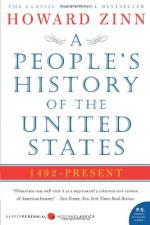|
This section contains 517 words (approx. 2 pages at 400 words per page) |

|
A People's History of the United States Summary & Study Guide Description
A People's History of the United States Summary & Study Guide includes comprehensive information and analysis to help you understand the book. This study guide contains the following sections:
This detailed literature summary also contains Topics for Discussion and a Free Quiz on A People's History of the United States by Howard Zinn.
"A People's History of the United States" by Howard Zinn is a work of non-fiction. The book is often recognized as one of the most accurate and valuable historical references in American history. The book begins with the world before Columbus came to the Americas and moves forward in chronological order until the year 2000. All major historical events are referenced in between those two times.
The book begins with Christopher Columbus' arrival in the Bahamas:
"Arawak men and women, naked, tawny, and full of wonder, emerged from their villages onto the island's beaches and swam out to get a closer look at the strange big boat. When Columbus and his sailors came ashore, carrying swords, speaking oddly, the Arawaks ran to greet them, brought them food, water, gifts" (Chap. 1, p. 1).
Columbus details his meeting with the Arawak in his ship's log, describing them as a people that would make fine slaves due to their ignorance. Columbus took some of the natives by force because he wanted to know where to find gold. Gold and spices were the two main things sought by Columbus as they were riches promised to the King and Queen of Spain. In return, Columbus would receive 10% of the profits from the sale of these goods.
Columbus never made it to Asia.
There is a great deal of emphasis on Columbus and other explorers in the beginning to show the existence of America before it was "discovered." Zinn discusses the brutality of those explorers and how they were determined to dominate and claim the goods of the land, e.g., gold, for their own and for their investors.
The history of enslavement continues with Cortes and Greenville. The story enters the United States at this point. The history of the Puritans and their battles with the natives begins. The Puritans began to spread out and to interfere with the lives and villages of the Pequot, Massachusetts, Narragansett, and other tribes. The relationships were relatively peaceful until the Puritans began to infringe on the natives, pushing them out of their native lands. The natives were not entirely innocent.
Zinn includes details that are often overlooked in the history books.
"Statistics tell the story. We find these in Michael Rogin's Fathers and Children: In 1790, there were 3,900,000 Americans, and most of them lived within 50 miles of the Atlantic Ocean. By 1830, there were 13 million Americans, and by 1840, 4,500,000 had crossed the Appalachian Mountains into the Mississippi Valley-that huge expanse of land crisscrossed by rivers flowing into the Mississippi from east and west. In 1820, 120,000 Indians lived east of the Mississippi. By 1844, fewer than 30,000 were left. Most of them had been forced to migrate westward. But the word "force" cannot convey what happened" (Chap. 7, p. 125).
The American Revolution is recounted.
Slavery is detailed in its many forms. This leads to the Civil War.
From the Civil War, Zinn moves forward very rapidly, covering the World Wars, Vietnam and up to the present. The War on Terror is briefly examined. Zinn asks readers to investigate American history further, to learn as much of the unbiased truth as possible.
Read more from the Study Guide
|
This section contains 517 words (approx. 2 pages at 400 words per page) |

|



